Kinds of Mud
This is the post you've been waiting for, in which I discuss and compare mud.
As a gardener I get intimate with dirt and notice its qualities. As a casual walker around the neighborhood, I have slipped in mud and gotten stuck in it, and I am here to tell you it is very different here in Santa Fe than it was back east.
In the east mud is boot-sucking. I've had that happen. I have stepped into a wet patch of dirt in my garden that sucked my boot right off, and momentum propelled my stockinged foot into wet glop on the next step. There's no recovery from that.
In the southwest mud is slimy and slippery. It's all sliding mineral content, no organic tilthy structure. You slip on a patch, it coats your shoes, and half an hour later it dries to a hard cement that can't be scraped off. I've tried digging hardened mud out of my sneaker treads with a screwdriver and it won't budge.
Ancient southwest people noticed that quality, and said let's make building bricks out of it. When dry they're hard, and we can even put a slippery mud coating over the bricks that will harden rock solid.
We'll call it adobe they said.
In the east thick chocolatey mud was spring's curse. It was at its worst just when I wanted to dig in the dirt to plant. There was a whole season to it in New England called, appropriately, Mud Season.
Here slick gumbo is a winter problem in the years we get snow. Slimy goop sticks to the wheel wells and door bottoms of cars and hardens there. It's kind of an amazing substance. The difference between this and the thick organic mud of the east fascinates me.
I promise my next post will not be about mud. But humor me. Right now I have to go get the power drill charged up and see if I can clean off the bottom of my shoes. I went for a walk yesterday and although my footwear did not get sucked off, I came home with 2 pounds of fresh adobe on my feet.


Comments